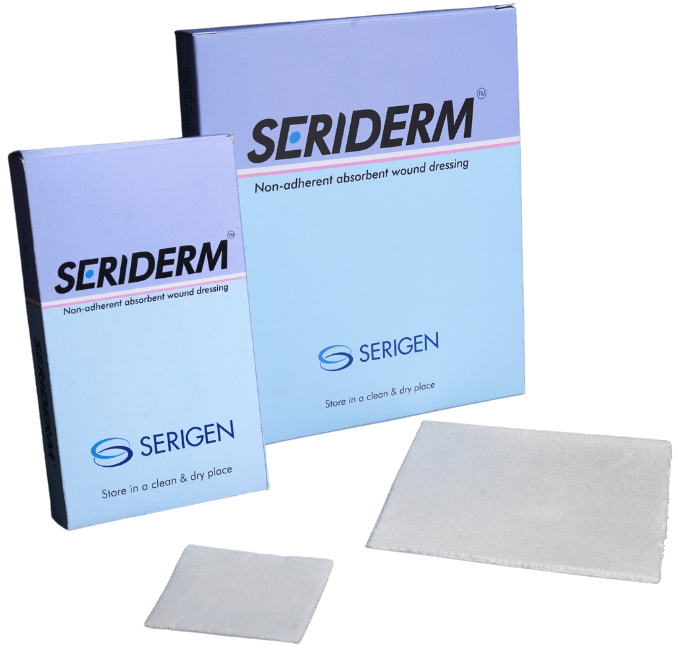Silk Protein In Medical Products – Current Landscape and The Road Ahead

Why Is Silk emerging as a promising biomaterial?
Silk is a proteinaceous material secreted by ~34000 species of spiders and ~1,13,000 insects which include, silkworms, flies, beetles, mites, and scorpions. Silk produced by silkworms is composed of two major proteins: 1) Silk Fibroin – a fibrous protein (SF) 70-80% and 2) Silk Sericin – a globular protein 20-30%. Silk fibroin is the main structural protein in the silk fiber, while the sericin protein forms a glue-like coating that maintains the shape of the cocoon. India is the second largest producer of silkworm silk. The silkworm silk thread has also been used as a medical suture since ancient times in 131-211 A.D. by Aelius Galenus – a Greek physician.
Silk Fibroin is made of both amorphous and crystalline domains. Gly-Ala amino acid repetitions are distributed throughout the crystalline domains via motifs containing tyrosine and serine amino acids. Amorphous domains are made up of bulky side-chain amino acids like aspartic acid. This unique structure gives silk the power to be processed to form a material as soft as a jelly or as hard as a bone using various chemical and mechanical treatments. Thus, silk can be processed into various shapes and forms using aqueous environment-friendly processing protocols. This can be achieved while retaining the inherent biocompatibility of the material. Due to this unique property, silk protein serves as a promising biomaterial for various biomedical applications that can utilize the different shapes and forms of silk.
Types of Silk Protein Being Used in the Medical Industry
Silk can be commonly classified as mulberry silk and non-mulberry silk. Mulberry silk is most extensively commercially produced by Lepidopterans larvae Bombyx mori (B.mori) belonging to the family Bombycidae. Non-mulberry silk is produced by the larvae belonging to the family Saturniidae II comprising non-mulberry species including –
- Antheraea mylitta (tasar silkworm) – Indian Species
- Antheraea assamensis (muga silkworm) – Indian Species
- Samia ricini (eri silkworm) – Indian Species
- Antheraea pernyi (temperate oak tasar silkworm) – Chinese Species and
- Antheraea yamamai (oak silkworm). – Japanese species
The silk from the B.mori silkworm can be produced with controlled quality in large commercial quantities and hence has been widely explored in medical use.
Benefits of Silk Protein for Biomedical Applications
Tissue repair is a complex process that includes a combination of cells, signalling molecules, and extracellular matrix proteins. Silk has excellent and proven biocompatibility, striking thermo-mechanical stability, tunable biodegradation and ease of processability. The mechanical properties of silk can also provide physical and chemical stimuli to cells for adhesion, and proliferation that supports cell differentiation.
The success of a biomaterial crucially depends on inflammatory responses. Silk has been reported for its low immunogenicity and Silk Fibroin also has a stronger ability to modify in response to one’s biological surroundings, resulting in better integration with silk-based biomaterial with less material-associated thrombosis. This opens up an enormous possibility of using silk motifs as the foundation for biomaterials.
Applications of Silk Protein as a Biomaterial
Silk is an FDA-approved biomaterial. Silk proteins are explored in various biomedical applications like SF-based photonic devices or biosensors, as an effective stabilizing agent to extend the shelf life of fruits and bio-pharmaceutical agents like vaccines and antibiotics. Silk Fibroin can be easily modulated to obtain required functionality and different forms including SF films, SF-3D scaffold, and SF-reinforced biomaterials.
The efficacy of SF-based biomaterials has been proven in various tissue regeneration models. A variety of different cell lines including mesenchymal stem cells, fibroblasts, osteoblasts, myoblasts, chondrocytes, keratinocytes and neurons have been demonstrated to adhere and extensively proliferate on SF matrices. Several studies have successfully demonstrated the use of Silk Fibroin as a biomaterial for vascular, neural, bone, ligament, cartilage, skin, intervertebral disc, heart, ocular and spinal cord tissue regeneration.
How is Serigen spearheading research to unleash the full potential of silk protein as a biomaterial?
Serigen is an innovation-driven tissue regeneration products company that leverages the materials science of natural silk protein derived from B.mori. Through its innovative processing protocols, Serigen exploits the processing flexibility provided by silk protein to formulate Seriderm – an all-in-one solution to wound management, Serioss – a bone void filler, and Serimat for soft tissue regeneration. Moreover, Serigen is the first company in the world to successfully conduct a clinical trial using silk in bone repair. Serigen’s novel technology and products have various biomedical applications that can address the unmet needs of diverse patient groups.
Conclusion
Silk is one of the most promising natural biopolymers conferred with excellent biocompatibility, low immunogenicity, tuneable mechanical properties, and regulated degradability with non-toxic by-products. The inherent physical-chemical properties confer silk with the potential to be engaged in a multitude of applications across the wide spectrum of healthcare products and modalities.
Silk continues to attract researchers all over the globe with its enormous potential for applications covering cosmetics, wound dressings, silk-based scaffolds for tissue regeneration, cancer therapeutics, tissue-on-chip screening platforms, tissue-engineered grafts and organs, food preservation, and bioremediation. Serigen is spearheading research and development in the field of silk-based medical devices, offering the immense benefits of silk protein as a biomaterial to patients across the globe.
References
1. A. Nisal, R. Sayyad, P. Dhavale, B. Khude, R. Deshpande, in: Silk fibroin micro- particle scaffolds with superior compression modulus and slow bioresorption for effective bone regeneration, Scientific Reports (2018), pp. 1–10, https://doi.org/10.1038/s41598-018- 25643-x.
2. N. Parekh, C. Hushye, S. Warunkar, S. Sen Gupta, A. Nisal, RSC advances in vitro study of novel microparticle based silk, RSC Adv. 7 (2017) 26551–26558, https:// doi.org/10.1039/C7RA03288A.
3. A. Bandyopadhyay, S. K. Chowdhury, S. Dey, J. C. Moses, B. B. Mandal, Silk: A Promising Biomaterial Opening New Vistas REVIEW. J. Indian Inst. Sci. (2019), 99 (3), 445–487. https://doi.org/10.1007/s41745-019-00114-y.
4. M. Vidya and S. Rajagopal: Silk Fibroin: A Promising Tool for Wound Healing and Skin Regeneration, Int.J. for Poly.Sci. (2021), https://doi.org/10.1155/2021/9069924

Author Bio – Nimisha Parekh is a Production Manager at Serigen Mediproducts. She holds a Ph.D in Biological Sciences from (the Academy of Scientific and Innovative Research (AcSIR)-National Chemical Laboratory and has 11 years of professional experience in diagnostics, research, development and scientific writing.

Why Is Silk emerging as a promising biomaterial?
Silk is a proteinaceous material secreted by ~34000 species of spiders and ~1,13,000 insects which include, silkworms, flies, beetles, mites, and scorpions. Silk produced by silkworms is composed of two major proteins: 1) Silk Fibroin – a fibrous protein (SF) 70-80% and 2) Silk Sericin – a globular protein 20-30%. Silk fibroin is the main structural protein in the silk fiber, while the sericin protein forms a glue-like coating that maintains the shape of the cocoon. India is the second largest producer of silkworm silk. The silkworm silk thread has also been used as a medical suture since ancient times in 131-211 A.D. by Aelius Galenus – a Greek physician.
Silk Fibroin is made of both amorphous and crystalline domains. Gly-Ala amino acid repetitions are distributed throughout the crystalline domains via motifs containing tyrosine and serine amino acids. Amorphous domains are made up of bulky side-chain amino acids like aspartic acid. This unique structure gives silk the power to be processed to form a material as soft as a jelly or as hard as a bone using various chemical and mechanical treatments. Thus, silk can be processed into various shapes and forms using aqueous environment-friendly processing protocols. This can be achieved while retaining the inherent biocompatibility of the material. Due to this unique property, silk protein serves as a promising biomaterial for various biomedical applications that can utilize the different shapes and forms of silk.
Types of Silk Protein Being Used in the Medical Industry
Silk can be commonly classified as mulberry silk and non-mulberry silk. Mulberry silk is most extensively commercially produced by Lepidopterans larvae Bombyx mori (B.mori) belonging to the family Bombycidae. Non-mulberry silk is produced by the larvae belonging to the family Saturniidae II comprising non-mulberry species including –
- Antheraea mylitta (tasar silkworm) – Indian Species
- Antheraea assamensis (muga silkworm) – Indian Species
- Samia ricini (eri silkworm) – Indian Species
- Antheraea pernyi (temperate oak tasar silkworm) – Chinese Species and
- Antheraea yamamai (oak silkworm). – Japanese species
The silk from the B.mori silkworm can be produced with controlled quality in large commercial quantities and hence has been widely explored in medical use.
Benefits of Silk Protein for Biomedical Applications
Tissue repair is a complex process that includes a combination of cells, signalling molecules, and extracellular matrix proteins. Silk has excellent and proven biocompatibility, striking thermo-mechanical stability, tunable biodegradation and ease of processability. The mechanical properties of silk can also provide physical and chemical stimuli to cells for adhesion, and proliferation that supports cell differentiation.
The success of a biomaterial crucially depends on inflammatory responses. Silk has been reported for its low immunogenicity and Silk Fibroin also has a stronger ability to modify in response to one’s biological surroundings, resulting in better integration with silk-based biomaterial with less material-associated thrombosis. This opens up an enormous possibility of using silk motifs as the foundation for biomaterials.
Applications of Silk Protein as a Biomaterial
Silk is an FDA-approved biomaterial. Silk proteins are explored in various biomedical applications like SF-based photonic devices or biosensors, as an effective stabilizing agent to extend the shelf life of fruits and bio-pharmaceutical agents like vaccines and antibiotics. Silk Fibroin can be easily modulated to obtain required functionality and different forms including SF films, SF-3D scaffold, and SF-reinforced biomaterials.
The efficacy of SF-based biomaterials has been proven in various tissue regeneration models. A variety of different cell lines including mesenchymal stem cells, fibroblasts, osteoblasts, myoblasts, chondrocytes, keratinocytes and neurons have been demonstrated to adhere and extensively proliferate on SF matrices. Several studies have successfully demonstrated the use of Silk Fibroin as a biomaterial for vascular, neural, bone, ligament, cartilage, skin, intervertebral disc, heart, ocular and spinal cord tissue regeneration.
How is Serigen spearheading research to unleash the full potential of silk protein as a biomaterial?
Serigen is an innovation-driven tissue regeneration products company that leverages the materials science of natural silk protein derived from B.mori. Through its innovative processing protocols, Serigen exploits the processing flexibility provided by silk protein to formulate Seriderm – an all-in-one solution to wound management, Serioss – a bone void filler, and Serimat for soft tissue regeneration. Moreover, Serigen is the first company in the world to successfully conduct a clinical trial using silk in bone repair. Serigen’s novel technology and products have various biomedical applications that can address the unmet needs of diverse patient groups.
Conclusion
Silk is one of the most promising natural biopolymers conferred with excellent biocompatibility, low immunogenicity, tuneable mechanical properties, and regulated degradability with non-toxic by-products. The inherent physical-chemical properties confer silk with the potential to be engaged in a multitude of applications across the wide spectrum of healthcare products and modalities.
Silk continues to attract researchers all over the globe with its enormous potential for applications covering cosmetics, wound dressings, silk-based scaffolds for tissue regeneration, cancer therapeutics, tissue-on-chip screening platforms, tissue-engineered grafts and organs, food preservation, and bioremediation. Serigen is spearheading research and development in the field of silk-based medical devices, offering the immense benefits of silk protein as a biomaterial to patients across the globe.
References
1. A. Nisal, R. Sayyad, P. Dhavale, B. Khude, R. Deshpande, in: Silk fibroin micro- particle scaffolds with superior compression modulus and slow bioresorption for effective bone regeneration, Scientific Reports (2018), pp. 1–10, https://doi.org/10.1038/s41598-018- 25643-x.
2. N. Parekh, C. Hushye, S. Warunkar, S. Sen Gupta, A. Nisal, RSC advances in vitro study of novel microparticle based silk, RSC Adv. 7 (2017) 26551–26558, https:// doi.org/10.1039/C7RA03288A.
3. A. Bandyopadhyay, S. K. Chowdhury, S. Dey, J. C. Moses, B. B. Mandal, Silk: A Promising Biomaterial Opening New Vistas REVIEW. J. Indian Inst. Sci. (2019), 99 (3), 445–487. https://doi.org/10.1007/s41745-019-00114-y.
4. M. Vidya and S. Rajagopal: Silk Fibroin: A Promising Tool for Wound Healing and Skin Regeneration, Int.J. for Poly.Sci. (2021), https://doi.org/10.1155/2021/9069924

Author Bio – Nimisha Parekh is a Production Manager at Serigen Mediproducts. She holds a Ph.D in Biological Sciences from (the Academy of Scientific and Innovative Research (AcSIR)-National Chemical Laboratory and has 11 years of professional experience in diagnostics, research, development and scientific writing.












